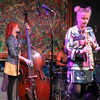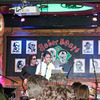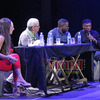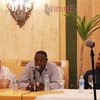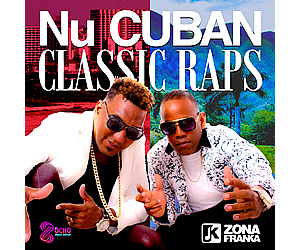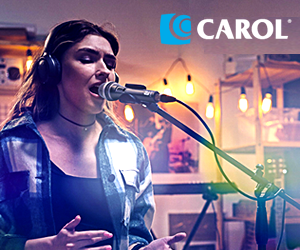Indice - Table of contents
New Stuff[hide]
Reportes: From The St... : Jazz Plaza ...
Fotos: Tom Ehrlich : Irakere 50th Annivers...
Fotos: Tom Ehrlich : Irakere
Resenas: Joey Altruda Presents: El Gran ...
Reportes: From The St... : Cubadisco 2...
Timbapedia: 09. Interviews -... : Carlos del Pino ...
Fotos: Tom Ehrlich : 2023 Monterey Jazz Fe...
Fotos: Tom Ehrlich : 2023 Monterey Jazz Fe...
Fotos: Tom Ehrlich : 2023 Monterey Jazz Fe...
Fotos: Tom Ehrlich : 2023 Monterey Jazz Fe...
Grupos: Tirso Duarte
Grupos: Tirso Duarte : Discography
Grupos: Charanga Habaner... : 8. El bla bla bla
Grupos: Pupy y los que S... : Tirso Duarte
Photos of the Day [hide]
SpanishEnglishDiscography - El puente - Y ahora baila
Y ahora baila
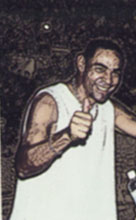 There are two approaches to Timba arranging, the more common of which begins with a salsa-flavored cuerpo and segues into more aggressive Timba when the coros and mambos begin. Then there's what I call Timba Dura -- arrangements like Issac's Con la punta del pie and LVV's Esto te pone la cabeza mala that dispense with the foreplay and blast out of the starting blocks at full throttle. Luis Bu's arrangement of Y ahora baila is Timba Durísima -- concise, compact, relentlessly powerful and funky as hell.
There are two approaches to Timba arranging, the more common of which begins with a salsa-flavored cuerpo and segues into more aggressive Timba when the coros and mambos begin. Then there's what I call Timba Dura -- arrangements like Issac's Con la punta del pie and LVV's Esto te pone la cabeza mala that dispense with the foreplay and blast out of the starting blocks at full throttle. Luis Bu's arrangement of Y ahora baila is Timba Durísima -- concise, compact, relentlessly powerful and funky as hell.
We've already heard the opening horn section at the end of audio example 1 [audio example 1] with its ultra-funk polyrhythmic climax. [audio example 3] Another riveting moment comes at the end of the bridge -- it's just a single punch on the backbeat after the coro sings "y llorarás", but it makes me scream every time I hear it. [audio example 4]
Adapting to the fact that Manolín has less vocal abilities to show off, the arrangements tend to be shorter and more to the point than, for example, those of Paulito, Issac and Van Van, who routinely surpass the 15 minute mark in their live performances. Y ahora baila lasts less than four minutes, but arranger Luis Bu (pictured above) fills every second of it with explosive intensity. Listen to the final mambo -- so simple and yet so effective. [audio example 5]
The exhilarating rhythm section performance is all the more impressive when you compare it to the studio version released on Manolín's fourth and final Cuban CD, "Jaque mate". In Cuba, Manolín had the luxury of a 5-piece percussion section consisting of drums, congas, timbales, bongó/campana, and güiro. The group that recorded "El puente" had only Tomás Cruz on congas (who later overdubbed the güiro part in the studio) and Reinier Guerra working triple overtime to cover the parts of drummer, campana and timbales, a feat that seems all the more Herculean when you consider that the studio version of Y ahora baila was already one of the fastest timba tracks ever recorded and that the live version is played considerably faster -- at a blistering 118 beats per minute! It's a sad commentary on both the bandleader and the US music scene that Manolín couldn't get it together to bring Angel "Pututi II" Arce on timbales for such an historic concert. Such compromises are commonplace here, where everyone plays in 8 bands, but in Cuba it would be unthinkable. I once missed hearing Klímax at Café Cantante because they were one trumpeter short and cancelled the gig. In Havana, if you don't have 14 well-rehearsed virtuosos, you don't show your face in public. In Miami, four or five burned-out músicos show up late from their Bar Mitzvah gig and play along with a drum machine. If you're really lucky, they might swap out the drum machine for a cassette tape with recordings of real horn players. Live music in South Beach is essentially Karaoke, but with better singers and considerably worse backup tracks.
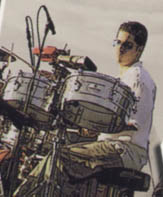 But this is not South Beach -- this is the great oasis of Rancho Gaspar -- La Tropical with real restrooms -- and Cruz and Guerra rise to the challenge magnificently. Listen again to the beginning of audio example 3 [audio example 3]. Listen carefully to the right side of your headphones. The lower sounding bell is the campana that the bongocero would be playing, but it's mounted on Reinier's drumset and played with a stick. But listen to the rapid-fire pattern on the higher bell. That's also Reinier! Everything except the congas and the güiro is Reinier, and although there's lots of overdubbing on this CD, the percussion, other than the güiro, is live and unedited. Before leaving this example, listen to the conversation between the rapid horn figure and the 3 open congas -- Reinier then puts a period on the sentence with a single cowbell hit, right on the backbeat...ahhhh...
But this is not South Beach -- this is the great oasis of Rancho Gaspar -- La Tropical with real restrooms -- and Cruz and Guerra rise to the challenge magnificently. Listen again to the beginning of audio example 3 [audio example 3]. Listen carefully to the right side of your headphones. The lower sounding bell is the campana that the bongocero would be playing, but it's mounted on Reinier's drumset and played with a stick. But listen to the rapid-fire pattern on the higher bell. That's also Reinier! Everything except the congas and the güiro is Reinier, and although there's lots of overdubbing on this CD, the percussion, other than the güiro, is live and unedited. Before leaving this example, listen to the conversation between the rapid horn figure and the 3 open congas -- Reinier then puts a period on the sentence with a single cowbell hit, right on the backbeat...ahhhh...
Guerra and Cruz are flat-out unconscious - not only do they maintain a throbbing groove but they catch all the bloques on the record and add many new ones, such as the wicked stop time break after Manolín sings the word "superficial". [audio example 6]
The heart and soul of this record is the performance of the 6-piece rhythm section of drums, congas, bass, guitar, piano and synth. Capturing this kind of electricity on a commercial recording is the real reason I consider "El puente" such an important milestone in Timba history.










